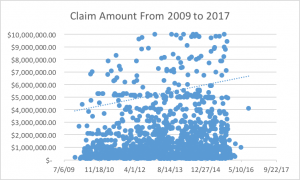Thanks to continued feedback from institutional partners and end users, our software team has been working diligently to develop some exciting new features. In the coming months you will see a focus on end user engagement and interaction throughout the DRD application.
The first quarter of 2017 has brought some exciting enhancements to facilitate end user detailed analysis, broaden currency collection methods, and focus on increased template functionality. Dispute Resolution Data will continue to seek out opportunities to observe and spend time with our end users, listening and learning, to help inform us of your most significant business challenges and how DRD can provide solutions. Here are some of our recent enhancements:
A Detailed Stats page for our data researchers. A series of filters located on the left column combined with our Case Type and Region Filters drive a series of stats that give the end user an in-depth look at granular data. For example, knowing that all arbitration cases are awarded in an average time of 67.7 weeks is interesting but when you filter the cases by size looking at cases between 100,000 and 1,000,000 USD you see that the average time falls to 65.9 weeks.
Our data collection template continues to evolve – DRD is now enabling end users to specify different currencies for any amount entered into the template for the situations where a contract currency may be different than the currency used to pay the institutional fees, and capturing new data on the amount in controversy for mediation cases. Collecting this new data will allow users to look at interesting trends on mediation in relation to amounts in controversy. Through your feedback we have continued to refine and add helper text throughout the template in an effort for data entry to be universally understood. This includes definitions explaining possible outcomes for case conclusions. These definitions can now be found on our FAQ page.
Finally, we have been focused on developing new statistics using trend data. DRD has been able to capture case data from the past seven years and will be developing graphs with user selectable date fields to display within the application. These graphs will be located in the Arbitration/Mediation navigation windows and will allow the end user to see how averages such as claim or award amounts have changed over time. Pictured below is a scatter plot that produces a correlation between claim amounts over time. In this example we are viewing the trend of claim amounts in international commercial arbitration cases from 2009 to 2017.
In the graph, the dotted trend line shows that the average claim has increased from $4,000,000.00 to almost $7,000,000.00 over the past seven years. An increase of over 50% during that time could point to a growing trust in commercial organizations in arbitration as a dispute resolution process.
This new functionality will add a new layer of interaction for our end users within the application to help them make data driven decisions.

